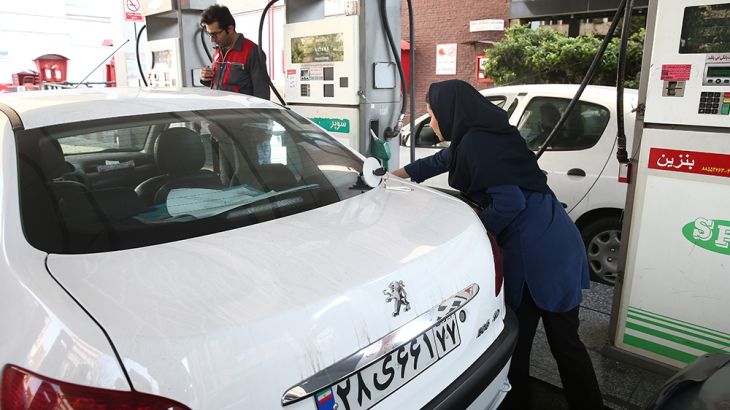Petrol rationing and price hikes take Iranians by surprise
Drivers in Iran were caught off-guard by snap plan that includes a steep increase in the cost of motor fuel.

Tehran, Iran – When 37-year-old apparel retailer Farshad was getting ready to go to sleep just after midnight on Friday, his phone alerts suddenly blew up with social media posts reacting to a government policy that many figured was in the pipeline, but that had still struck without warning.
The government in Iran had announced that – effective immediately – petrol would be rationed and prices would triple.
Keep reading
list of 4 itemsWho will be Iran’s next president? | Start Here
Oil slumps two percent on possible return of Iranian supply
Border security a common concern for Pakistan and Iran: Rouhani
“I guess we all knew this was happening one way or another, since the government has been reintroducing fuel cards for rationing,” said Farshad, who asked Al Jazeera to withhold his surname to protect his privacy. “But a midnight announcement and this price hike came out of nowhere.”
In the early hours of Friday morning, Iranian state television broadcasted a statement by the National Iranian Oil Products Distribution Company saying petrol will now be rationed across the country using smart fuel cards.
Vehicles for private use are to be restricted to 60 litres (16gal) of fuel monthly, while the price of petrol will jump 50 percent to 15,000 Iranian rials ($0.13 at open market rates) per litre. Any fuel purchases in excess of allotted rations will incur an additional charge of 30,000 rials ($0.26) per litre.
‘We’re all drowning’
In early May, after hardline Iranian news websites reported that fuel rationing was imminent, long queues formed at petrol stations all over the country.
Friday’s news was not telegraphed in advance, but people still started queueing at petrol stations. Though the price hike was immediate, any unused monthly ration quotas can be saved for up to six months.
Petrol in Iran – the world’s number five oil producer – is cheaper than in most countries. That could bolster justifications for a price hike, given the beating that Iran’s budget has sustained since the administration of United States President Donald Trump started applying its “maximum pressure” campaign of sanctions on Iran over a year ago.
Still, as many Iranians pointed out on social media, average incomes are too low to comfortably absorb the fuel price hike.
“I wish economic austerity wasn’t only for average people. That way this would hurt less,” wrote a journalist on her Instagram account. “We’re all drowning, it’s only a matter of time.”
Iranians, especially those getting by on low- and middle-income wages, have taken a massive hit due to a currency crisis and an inflationary wave that formed on the back of US sanctions imposed after the Trump administration unilaterally withdrew from Iran’s nuclear deal with world powers.
‘At the expense of the people’
The government of President Hassan Rouhani has tried to reassure the general public that the initiative is meant to help improve peoples’ quality of life.
Mohammad Baqer Nobakht, head of the Plan and Budget Organization of the Islamic Republic of Iran, announced that the revenues from the initiative will be distributed among 18 million households – about 60 million people – in the form of monthly cash handouts.
A family of five or more will receive 2.05 million rials (around $18). This is separate from the 445,000 rials ($3.90) that each household member is eligible to receive under Iran’s long-running monthly state cash subsidies plan.
According to the Rouhani administration, not a single rial yielded from the rationing initiative will go to government coffers.
“The government is doing it differently this time, but it still feels like they’re trying to make up for their deficits at the expense of the people,” said Saeed, a 48-year-old architect who asked Al Jazeera to withhold his surname.
“And whenever gasoline prices go up, prices of other goods go up, too, so I doubt the cash handouts will be able to make up for it,” he told Al Jazeera.
‘Can afford less fuel’
The populist administration of former President Mahmoud Ahmadinejad in 2007 rationed gasoline and increased prices, but that move failed to curb rampant fuel smuggling or decrease consumption.
Some Iranians on social media have pointed to the irony of a 2015 tweet by President Rouhani, in which he said, “Gasoline offered at two prices created corruption, so we unified the prices”.
Iran has some of the largest energy reserves in the world, but due to limited refining capacity – and sanctions that limited the supply of spare parts for plant maintenance – it has for years faced an uphill battle in meeting its domestic fuel needs.
Despite the public dissatisfaction and anger, some Iranians still hold out hope that a silver lining may emerge from the rationing scheme if fewer people are driving. Tehran has been battling smog and air pollution for the past week that led to the closure of schools.
“People are under so much pressure,” said 27-year-old Tehran resident Anahid, who asked that his surname be withheld. “But there’s no denying this pollution and traffic either, so maybe more people will turn to public transport if they literally can afford less fuel.”